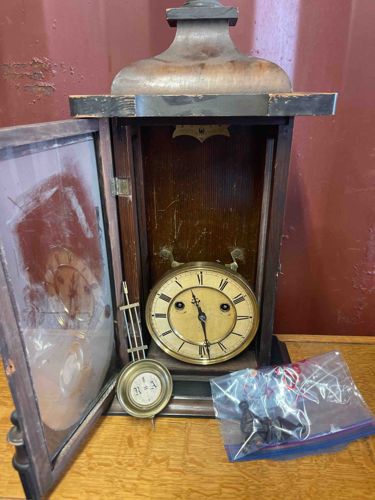
Antique or Vintage Mantel/Wall Clock (Disassembled)
This is an antique or vintage domestic wall clock, likely a mantel clock or bracket clock, presented in a disassembled or inoperative state. Its construction consists primarily of dark-stained wood, possibly oak or a similar hardwood, with a rectangular case and a distinctive domed or architectural pediment top. The wood finish shows significant wear, chips, and scratches, particularly on the top pediment and the edges of the case, indicating age and handling. The front door, with glass intact, is open and detached from its hinges, revealing the inner workings. The glass itself appears to have some smudges or internal condensation, obscuring a clear view. Inside the case, the brass clock mechanism is visible, featuring a circular dial with Roman numerals for hours and what appear to be simple, dark-colored hands. Two winding holes are present on the dial at approximate 4 and 8 o'clock positions, indicating a chiming or striking mechanism in addition to timekeeping. The dial itself has a aged patina, a common characteristic of brass. Below the clock mechanism, a pendulum assembly, also primarily brass, is separated from its hanging point, lying on the base of the clock. Its bob is flat and round, with what appears to be a stamped design or marking on its face. Above the mechanism, a small, decorative brass escutcheon or plaque with a 'W' symbol is visible, which could be a manufacturer's mark or part of a model designation. The overall aesthetic suggests a late 19th to early 20th-century period, consistent with the style of many American or European mass-produced clocks of that era. The presence of a plastic bag containing various small metal parts, likely keys, weights, or other components necessary for operation, further confirms its incomplete or non-functional status. The craftsmanship is utilitarian, typical of a production-line item, rather than bespoke, with some evident joint lines and hardware for the door. Visible condition issues include wood damage, wear to the finish, and the detached door, suggesting the clock requires restoration to be functional and aesthetically complete.
AI-Generated Appraisal Disclaimer
Estimated Value
$40-$80
Basic Information
Category
Timepiece
Appraised On
December 1, 2025
Estimated Value
$40-$80
Item Description
This is an antique or vintage domestic wall clock, likely a mantel clock or bracket clock, presented in a disassembled or inoperative state. Its construction consists primarily of dark-stained wood, possibly oak or a similar hardwood, with a rectangular case and a distinctive domed or architectural pediment top. The wood finish shows significant wear, chips, and scratches, particularly on the top pediment and the edges of the case, indicating age and handling. The front door, with glass intact, is open and detached from its hinges, revealing the inner workings. The glass itself appears to have some smudges or internal condensation, obscuring a clear view. Inside the case, the brass clock mechanism is visible, featuring a circular dial with Roman numerals for hours and what appear to be simple, dark-colored hands. Two winding holes are present on the dial at approximate 4 and 8 o'clock positions, indicating a chiming or striking mechanism in addition to timekeeping. The dial itself has a aged patina, a common characteristic of brass. Below the clock mechanism, a pendulum assembly, also primarily brass, is separated from its hanging point, lying on the base of the clock. Its bob is flat and round, with what appears to be a stamped design or marking on its face. Above the mechanism, a small, decorative brass escutcheon or plaque with a 'W' symbol is visible, which could be a manufacturer's mark or part of a model designation. The overall aesthetic suggests a late 19th to early 20th-century period, consistent with the style of many American or European mass-produced clocks of that era. The presence of a plastic bag containing various small metal parts, likely keys, weights, or other components necessary for operation, further confirms its incomplete or non-functional status. The craftsmanship is utilitarian, typical of a production-line item, rather than bespoke, with some evident joint lines and hardware for the door. Visible condition issues include wood damage, wear to the finish, and the detached door, suggesting the clock requires restoration to be functional and aesthetically complete.
Get Your Items Appraised
Instant estimates of your treasures with AI-powered instant appraisals